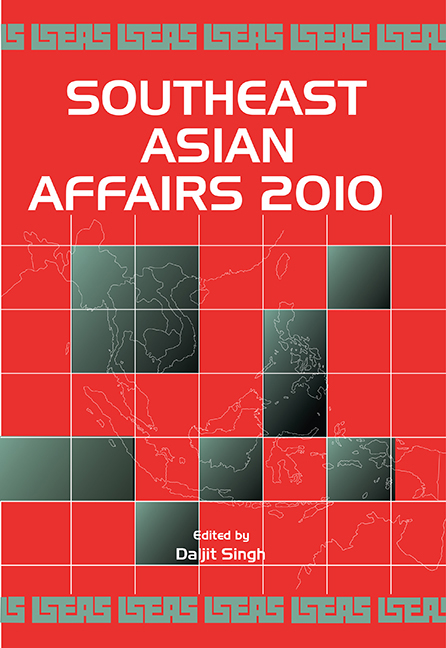Book contents
- Frontmatter
- Contents
- Foreword
- Introduction
- THE REGION
- Southeast Asia in 2009: A Year Fraught with Challenges
- Review of Southeast Asian Economic Developments
- The United States and China in Southeast Asia: Conflict or Convergence?
- The Year in ASEAN: The Charter, Trade Agreements, and the Global Economic Crisis
- BRUNEI DARUSSALAM
- CAMBODIA
- INDONESIA
- LAOS
- MALAYSIA
- MYANMAR
- THE PHILIPPINES
- SINGAPORE
- THAILAND
- TIMOR-LESTE
- VIETNAM
The United States and China in Southeast Asia: Conflict or Convergence?
from THE REGION
Published online by Cambridge University Press: 21 October 2015
- Frontmatter
- Contents
- Foreword
- Introduction
- THE REGION
- Southeast Asia in 2009: A Year Fraught with Challenges
- Review of Southeast Asian Economic Developments
- The United States and China in Southeast Asia: Conflict or Convergence?
- The Year in ASEAN: The Charter, Trade Agreements, and the Global Economic Crisis
- BRUNEI DARUSSALAM
- CAMBODIA
- INDONESIA
- LAOS
- MALAYSIA
- MYANMAR
- THE PHILIPPINES
- SINGAPORE
- THAILAND
- TIMOR-LESTE
- VIETNAM
Summary
The year 2009 witnessed important initiatives by the United States and China in Southeast Asia. Evidence of some sharpening of Sino-American competition to protect interests and project influence in Southeast Asia grew amid a broader pattern of mixed divergence and convergence in Sino-American relations over such important international concerns as the global economic crisis and recession begun in 2008, climate change, the armed conflicts, instability in Afghanistan and Pakistan, and Iran's and North Korea's nuclear weapons development.
On balance, the leaders of both countries remained committed to a path of constructive engagement that has marked Sino-American interchange since early in the decade. Differences over various issues, including respective efforts to improve influence and protect interests in Southeast Asia, have tended to be dealt with through various private channels or formal “dialogues”, out of the public limelight. Neither side has taken steps in their respective foreign policy initiatives that would seriously jeopardize the positive stasis that has developed in relations between the American and Chinese governments.
Many significant differences and strongly competing interests remain in U.S.-China relations, including in Southeast Asia. They feed deeply rooted mutual suspicions and impede progress in developing closer U.S.-China relations based on mutual trust. But the positive benefits of Sino-American engagement, ever closer mutual interdependence in U.S.-Chinese interests, especially in economic development, and massive preoccupations of both leaderships with other problems at home and abroad mean that neither the United States nor the Chinese government appear to see its interest well served with a disruptive confrontation with the other. This balance of interests foretells continued careful management of Sino- American differences in Southeast Asia as the United States and China pursue initiatives and compete for influence in the region.
RECENT SOUTHEAST ASIAN DEVELOPMENTS
U.S. Initiatives and China's Response
The incoming administration of President Barack Obama wasted little time in notifying the region and the world that the United States was “back” in Southeast Asia, pursuing active engagement. Secretary of State Hillary Clinton committed to attending regularly the annual ministerial meeting of the Association of Southeast Asian Nations (ASEAN) Regional Forum (ARF), which her predecessor had missed as often as not. The United States joined ASEAN's Treaty of Amity and Cooperation in a step that improved U.S. relations with Southeast Asian countries and offered possible U.S. participation in the Asian Leadership Summit conveyed by the ASEAN-anchored East Asia Summit forum.
- Type
- Chapter
- Information
- Southeast Asian Affairs 2010 , pp. 44 - 59Publisher: ISEAS–Yusof Ishak InstitutePrint publication year: 2010



